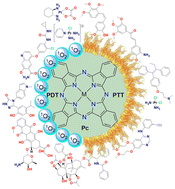Targeted cancer phototherapy using phthalocyanine–anticancer drug conjugates
Abstract
Phototherapy, the use of light to selectively ablate cancerous tissue, is a compelling prospect. Phototherapy is divided into two major domains: photodynamic and photothermal, whereby photosensitizer irradiation generates reactive oxygen species or heat, respectively, to disrupt the cancer microenvironment. Phthalocyanines (Pcs) are prominent phototherapeutics due to their desirable optical properties and structural versatility. Targeting of Pc photosensitizers historically relied on the enhanced permeation and retention effect, but the weak specificity engendered by this approach has hindered bench-to-clinic translation. To improve specificity, antibody and peptide active-targeting groups have been employed to some effect. An alternative targeting method exploits the binding of anticancer drugs to direct the photosensitizer close to essential cellular components, allowing for precise, synergistic phototherapy. This Perspective explores the use of Pc–drug conjugates as targeted anticancer phototherapeutic systems with examples of Pc–platin, Pc–kinase, and Pc–anthracycline conjugates discussed in detail.

- This article is part of the themed collections: New Talent: Europe and 2022 Frontier and Perspective articles


 Please wait while we load your content...
Please wait while we load your content...